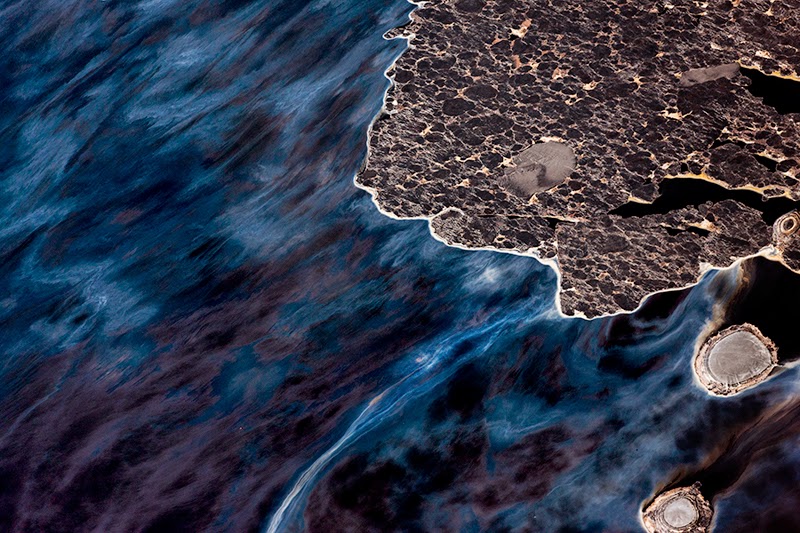Two shows open Fri., Nov. 21, at Giampietro Gallery at Erector Square
Giampietro Gallery—Works of Art
315 Peck St., New Haven, (203) 777-7760
Elizabeth Gilfilen: Laid Ledge
Jeremy Chandler: Prone Positions
Nov. 21—Dec. 20, 2014.
Reception: Fri., Nov. 21, 6—8 p.m.
Press release from Giampietro Gallery
FRED.GIAMPIETRO Gallery is pleased to present Laid Ledge, an exhibition of new work by Elizabeth Gilfilen and Prone Positions, an exhibition of new work by Jeremy Chandler. This is Elizabeth's and Jeremy's first solo shows with the gallery.
Elizabeth Gilfilen writes:
The title of this exhibition, Laid Ledge alludes to the painting act, and to locating the physical and perceived edge of uncertainty. With paint, I move fluidly through the work, and I record each misstep. Accumulated marks grow and deviate; torquing forms emerge based on the decisions I make. A kinetic energy can overwhelm, yet I strive for a tension in the marks that is sprung almost as tight as the coils and tendons that create them. It is the alternating recognition of corporeal form and its immediate denial that causes me to revisit the work over many months. Over time, the scaffolding of marks can collapse into overlapping landscapes, defined by risk and just out of reach.
 | |
| Artwork by Elizabeth Gilfilen |
Elizabeth Gilfilen received her BFA from the University of Cincinnati and her MFA from Virginia Commonwealth University. Awards include: Yaddo, The Marie Walsh Sharpe Foundation Space Program, Gallery Aferro Studio Residency, The Bronx Museum's AIM Program, and the Robert Blackburn Printmaking Workshop SIP Fellowship. Exhibitions include: Morgan Lehman Gallery, NY, Reynolds Gallery, Richmond, VA, the Aldrich Contemporary Art Museum, CT, and the Hunterdon Museum of Art, Clinton, NJ. Her work will be published in New American Paintings; and has been reviewed in Two Coats of Paint, The Boston Globe, The Newark Star-Ledger and The New York Times.
In a recent statement, Jeremy Chandler describes his work:
My art practice has grown out of a desire to express my own personal history; experiences, relationships, and identity through a prolonged engagement with place and a process that emphasizes shared experiences with those I photograph. I create content through a variety of conceptual and formal approaches, such as straight photography, tableaus and documentary and narrative film projects. Throughout, futility, ritual, sublimity, land use and methods of concealment are all recurring themes in my work. My visual language is informed by my own memories, cultural mythology, and depictions of masculine identity through cinema, art history, and popular culture. I am interested in subverting ritualized expressions of masculinity to reveal a more nuanced idea of maleness and how culture and myth can often intertwine to create altered perceptions of space and place.
_2011.jpg) | |
| Jeremy Chandler: "Ghillie Suit (Pine Straw)" |
In my most recent photographs, I construct images by repurposing methods utilized by hunting and military culture, turning otherwise weaponized techniques into benign aesthetic devices. I activate spaces that are typically already known to me, through the introduction of people, found and homemade props, and cinematic methods of storytelling.
Jeremy Chandler received his BFA from the University of Florida and his MFA from the University of South Florida. Jeremy's work has been exhibited in many prestigious galleries and museums both nationally and internationally. Chandlre's work will be published in Ellen Mueller's new publication titled, Elements and Principles of 4D Art and Design; and has been reviewed in Oxford American Magazine, The News Herald, and The Daily Loaf. Chandler's work can be found in The Center for Fine Art Photography in Fort Collins, CO, All Children's Hospital in St. Petersburg, FL and other public and private collections.
Labels: Elizabeth Gilfilen, Giampietro Gallery—Works of Art, Jeremy Chandler, painting, photography









